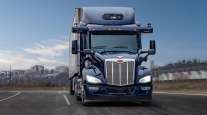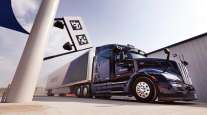The Dallas Morning News
Inside an Aurora Self-Driving Truck Testing in Texas
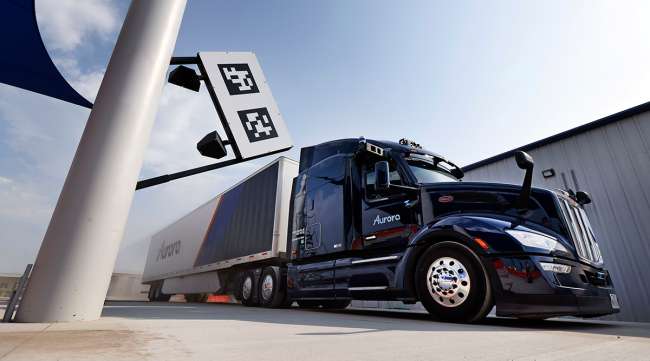
[Stay on top of transportation news: Get TTNews in your inbox.]
PALMER, Texas — Darcy Desjarlais, senior truck operations specialist at Aurora, hovers both hands under the steering wheel of Aurora’s self-driving truck as it cruises at 65 mph down Interstate 45, heading in its typical route toward Houston.
Above his palms could be the future of short and long hauls for transported goods.
To his right sits Riliwan Fabanwo, truck operations specialist at Aurora, monitoring the roads for any objects, slow-moving cars or challenges the Aurora technology faces. Sensors track up to 400 meters ahead and behind the truck, nearly 360 degrees around the big rig’s front, back and sides.
“I feel like this is the future for trucking,” said Fabanwo, who has been with Aurora for over a year.
Investments and research into autonomous trucking have boomed over the last several years, and Texas is viewed as a prime testing ground for companies trying out the emerging technology. It only became possible through the advancement of technology, according to Gopal Gupta, professor of computer science and co-director of the University of Texas at Dallas Center for Applied AI and Machine Learning.
“Autonomous driving has a significant appeal to everybody,” Gupta said.
With a trailer attached, an Aurora truck stretches 72 feet long, 8.5 feet wide and 13.5 feet tall. The cab is 30,000 pounds and hauls 50,000 pounds of goods, a gross weight of up to 80,000 pounds. Everything about the truck has a purpose.
And by the end of 2024, the same Aurora truck could be completely driverless along the same route. That’s what self-driving trucking firm Aurora envisions for the future of autonomous vehicles in Texas.
The Dallas Morning News went on a ride along for a preview of Aurora’s Dallas to Houston route.
How It Works
As soon as Desjarlais starts up the truck, he manually maneuvers it to drive over the launch pads in the ground at the Palmer terminal. These launch pads are built into the ground to begin and end the autonomous driving process. By then, the Aurora technology is aware of where it will be heading on its trip.
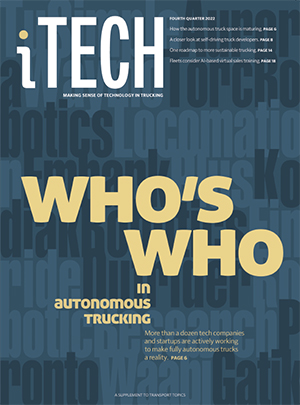
Who's Who in the Autonomous Space
►Overview of Self-Driving Truck Development
Company Sketches
Click the links to jump to profiles of autonomous companies.
Aurora | Waymo | TuSimple | Gatik | Locomation | Torc Robotics | Waabi | Einride | Plus | Embark | Kodiak Robotics | Robotic Research | Outrider | Pronto
Once the truck is ready, a green light flickers on and the truck is fully autonomous. The safety drivers keep their hands close to the steering wheel and foot near the brake in case they need to take the truck out of autonomy.
There are five ways to stop automation: hitting the gas, hitting the brake, manually adjusting the steering wheel, hitting the manual off button and pressing a red button for emergency stops.
Aurora’s technology is a self-driving system with hardware and software designed to adapt to a broad set of vehicles, in this case, Class 8 semi-trucks. The sensor pods in the truck contain lidar, radar and cameras. There are approximately 25 different cameras and sensors around the vehicle.
Lidar allows the truck to drive safely at high speeds. Lidar, also known as light detection and ranging, is a remote sensing method that uses laser waves to measure distances.
Ossa Fisher, president of Aurora Innovation Inc., tries to test the technology as frequently as she can. Fisher, 46, took the job at Aurora earlier this year, after serving as president and chief operating officer of Istation, a Dallas firm that creates game-like educational technology, for nearly eight years.
Fisher said the truck will never exceed the speed limit, and typically goes under it. Aurora trucks will speed up to change lanes.
Aurora tests and retests as many conceivable scenarios as it can in simulations, she said.
“There are scenarios that are maybe one-in-a-million type of scenarios on an average road,” Fisher said. “Like a five-car pileup. What would we do? We wouldn’t ever want that created for us in real life, but we can simulate it and say what would we do.”
But as it cruises along in autonomy, safety drivers monitor indicators on the Aurora dashboard. It gives badges and shows different-colored shapes for the objects or people it picks up along routes, up to 400 meters around the truck.
One of the badges resembles a snail, a sign of a nearby slow-moving vehicle traveling dangerously under the speed limit. The Aurora truck monitors the vehicle to determine whether to make a lane change or maintain distance.
“If (a car near the Aurora truck is) driving well below the speed limit, we give them a snail badge and it’s a cute little blue snail and that tells the Aurora driver that it’s likely time to change lanes and speed up and take over that vehicle,” Fisher said.

Aurora's Desjarlais keeps his hands near the wheel of a semi during a supervised autonomous driving preview route. (Tom Fox/The Dallas Morning News/TNS)
In 2017, Aurora was founded by Chris Urmson, Sterling Anderson and Drew Bagnell. Urmson helped build Google’s self-driving platform from 2009 to 2016, as chief technology officer for the team. He published a blog post in 2016 on Medium saying he was “ready for a fresh challenge.” By 2020, the self-driving company had expanded its operations to Texas.
In April, Aurora opened its first commercial-ready terminal for driverless trucks in Palmer, Texas. The terminal has trucks pulling freight for pilot customers such as FedEx, Schneider and Uber Freight between Dallas and Houston. Aurora has 170 employees in Texas and 1,700 in the whole company.
The terminal has drive-through sensor calibration ranges that resembles QR codes, which the truck will pass through to calibrate sensors. There are also data offload centers resembling gas pumps.
“There’s a few things that make this a little bit different than your typical prepping terminal,” Fisher said.
Aurora has 31 trucks in its fleet.
Safety First
Fisher has always felt safe in the back of an Aurora driving truck.
“It’s showing you what it’s seeing,” Fisher said. “It’s also making decisions on when it’s going to change the lane, when it’s going to speed up, when it’s going to slow down.”
Safety is the company’s No. 1 priority, especially as it enters a market that’s still fairly new to autonomous driving.
So, for now, practice makes perfect. Aurora is running its test routes with two drivers in place, gathering data to make sure the truck can handle Texas roads on its own come the end of 2024. According to the Texas Department of Transportation, there were 4,481 motor vehicle deaths last year in the state.

Guy Broderick of Kriska shares how he successfully combined data reports and a simple understanding of human nature to become one of the best driver coaches in North America. Tune in above or by going to RoadSigns.ttnews.com.
Fisher said the Aurora technology can see pedestrians in the dark during rain or fog. It also can track whether vehicles on the road are too close to the truck. The biggest challenge is icy and snowy weather, she said. That’s one of the reasons Aurora planted roots in Texas.
“There are reasons why even commercial airlines don’t fly in certain weather, but there’s no such provision on public roads,” Fisher said. “There’s no law that says you can’t get roads ... what we need to decide is it even safe to try.”
While the technology is still being perfected, it already has some advantages over human drivers. One of the perks of autonomous vehicles carrying freight is the safety aspect of it, Gupta said. An autonomous vehicle doesn’t feel fatigue or tiredness like a human driver would, he said.
But there’s a list of boxes the company wants to check before it removes its safety drivers.
Over the next few months, the company will evaluate safety repeatedly to ensure it’s ready for every potential obstacle and scenario. The company expects to achieve this by the end of 2023.
Aurora expects the commercial launch to come in the latter half of 2024 with a fleet of approximately two dozen trucks traveling between Dallas and Houston.
“We want to be an exemplar in terms of what it means to be safe on the roads,” Fisher said.
When safety drivers are finally pulled back, she said, those drivers can pursue careers in other parts of the company. Aurora doesn’t see the profession dissolving with the use of autonomous vehicles, she said.
“We believe that the employee base will continue to grow and thrive,” Fisher said.
Friendly Competition
Texas has become a hot spot for autonomous vehicle testing.
Waymo, a subsidiary of Google’s parent company, Alphabet Inc., opened a 9-acre self-driving trucking facility in Lancaster last year. The company has pursued longhaul routes in Texas, New Mexico and Arizona.
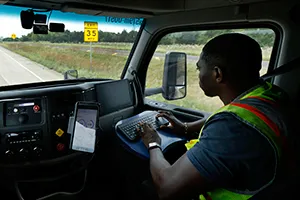
Aurora's Fabanwo records route information during the preview drive. (Tom Fox/The Dallas Morning News/TNS)
Gatik, a California-based autonomous trucking company, announced in March it will be making multiple deliveries a day, seven days a week for Kroger from its fulfillment center.
Kodiak Robotics’ Texas fleet is based in Lancaster. Kodiak runs a 24-hour-a-day operation, using its autonomous technology with a safety driver behind the wheel monitoring the system. The company delivers about 50 loads a week between Dallas-Fort Worth, Houston, Austin, San Antonio, Oklahoma City and Atlanta. It’s also working with commercial customers, such as C.R. England, Tyson Foods, Ikea, Werner Enterprises, US Xpress, Forward and others.
Cruise, a San Francisco-based company, expanded its operations to Dallas and Houston. It already offers services in Austin, Phoenix and San Francisco without a backup driver. The company plans to deploy the cars in Dallas this summer.
The race to get autonomous driving vehicles on the road has already had some business casualties, though. TuSimple had some operations set up in North Texas. In January, the company announced 76 layoffs in the area, citing a need to restructure the firm, which ultimately wiped out its Texas operations. The company is still testing near its facility in Tucson, Ariz., but intends to expand into Texas at some point in the future.
From Aurora’s hub in Palmer, Fisher said the company feels it can expand out easily. Texas is a big business state that is friendly to innovation, making it an easy transition, she said. She said Aurora could go next to Phoenix or Atlanta, but the company will go wherever the demand lies.
At the end of the day, the truck driving profession won’t go away anytime soon with the addition of autonomous trucks, Gupta said. It’s an important job that many rely on.
“More advancements have to be made and incorporated into how autonomous trucking or autonomous driving is done,” Gupta said.
Fisher believes trucking is the “backbone of the economy.”
“Everything we’re wearing today was completely brought to us on a truck,” Fisher said. “This is creating opportunities to stay in trucking, but in ways that allow people to be with their family at night.”
Want more news? Listen to today's daily briefing below or go here for more info:
Distributed by Tribune Content Agency, LLC


